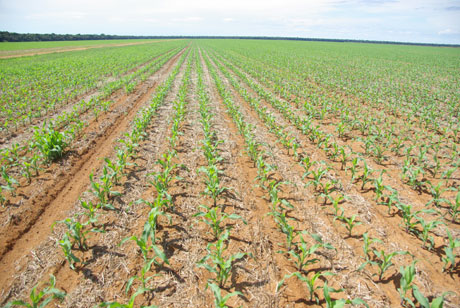New MBL/Woods Hole Research Center Projects to Address Environmental Impacts of Agriculture Expansion in Amazon

Contact: Gina Hebert
508-289-7725; ghebert@mbl.edu
MBL, WOODS HOLE, MA—A decade ago, Brazil was losing an area of rainforest about the size of Massachusetts each year to cattle pasture and croplands. Recently, deforestation has slowed because agriculture is intensifying and allowing farmers to produce more crops on the same land. Nowhere is this more evident than in the state of Mato Grosso, Brazil, where large soybean farms now stretch to the horizon across an area almost the size of Maine.
Two new studies led by Christopher Neill, director of the Ecosystems Center at the Marine Biological Laboratory (MBL), and his colleagues Michael Coe and Marcia Macedo of the Woods Hole Research Center (WHRC), and WHRC Distinguished Visiting Scientist Eric Davidson, will examine the environmental impacts of the expansion and intensification of Amazon soybean agriculture and identify potential management strategies to reduce those impacts. The National Science Foundation (NSF) is funding both projects for a total of $1.96 million that will be awarded jointly to MBL and WHRC. Both projects will include collaborations with the Institute for Amazon Environmental Research (IPAM) and the University of São Paulo (USP).
 Corn planting at Tanguro Ranch in Mato Grosso, Brazil. Corn planting immediately followed harvest of an earlier soybean crop. Double cropping is rapidly expanding at the agricultural frontier in Mato Grosso. Original tropical rainforest in the background.
Corn planting at Tanguro Ranch in Mato Grosso, Brazil. Corn planting immediately followed harvest of an earlier soybean crop. Double cropping is rapidly expanding at the agricultural frontier in Mato Grosso. Original tropical rainforest in the background.Soybean farms have become a major portion of the economy of the Brazilian Amazon in the last ten years. Recently Amazon farmers have begun shifting from planting a single soybean crop to double cropping soybeans with corn or cotton in the same tropical rainy season. The second crops require a large application of nitrogen fertilizer, the ecological consequences of which are unknown. Intensive nitrogen fertilizer application in the United States, China, and other heavily-farmed temperate regions leads to significant release of nitrous oxide (a powerful greenhouse gas) to the atmosphere and the leaching of nitrogen through soils and into adjacent streams and rivers. But deep topical soils and differences between temperate and tropical climates and farming practices suggest that the responses may be very different in the Amazon. Greenhouse gas emissions may be higher but leaching to streams may be lower.
In one of their new projects, the team of researchers will measure greenhouse gas emissions and nitrogen leaching to streams on a 200,000-acre soybean farm in Mato Grosso. This data will allow them to pinpoint where nitrogen goes once it has been applied to the fields. They will combine this new information with satellite observations and computer models to predict the implications of future cropland expansion and intensification throughout the Amazon for stream health and global greenhouse gas concentrations.
Through this work the research team aims to develop a better understanding of the nitrogen cycle in the tropics. The results of these studies will aid in the design of more ecologically sound farming approaches to reduce potentially important environmental consequences on the global atmosphere and regional water quality.
The other new project is supported by the Belmont Forum and headquartered in Brazil under the leadership of Alex Krusche, (Neill and Coe's long-time colleague at the University of São Paulo). The group will examine how changes to regional climate caused by global climate change and agricultural expansion will affect the security of rainfall and fresh water supply in the Upper Xingu River Basin of Mato Grosso. The Belmont Forum is an international consortium supported by NSF and the project team has members from the University of Potsdam, the University of British Columbia as well as MBL, WHRC and USP.
Neill and his colleagues will study how impacts from land conversion and agricultural intensification interact to affect the region’s water cycle, water quality and stream habitats. They hope to identify the thresholds that could endanger agricultural production and traditional regional livelihoods. They will also examine effects on downstream water-related infrastructure, because higher stream and river flows are one consequence of decreased forest cover.
By involving farmers, cattle ranchers, municipal officials, and others, Neill, Coe, and their team will determine to what extent virtual water and hydrological modeling tools can influence stakeholder understanding of water security and they will seek to identify potential institutional mechanisms to manage inevitable water tradeoffs.
—###—
The MBL is dedicated to scientific discovery and improving the human condition through research and education in biology, biomedicine, and environmental science. Founded in Woods Hole, Massachusetts, in 1888, the MBL is a private, nonprofit institution and an affiliate of the University of Chicago.